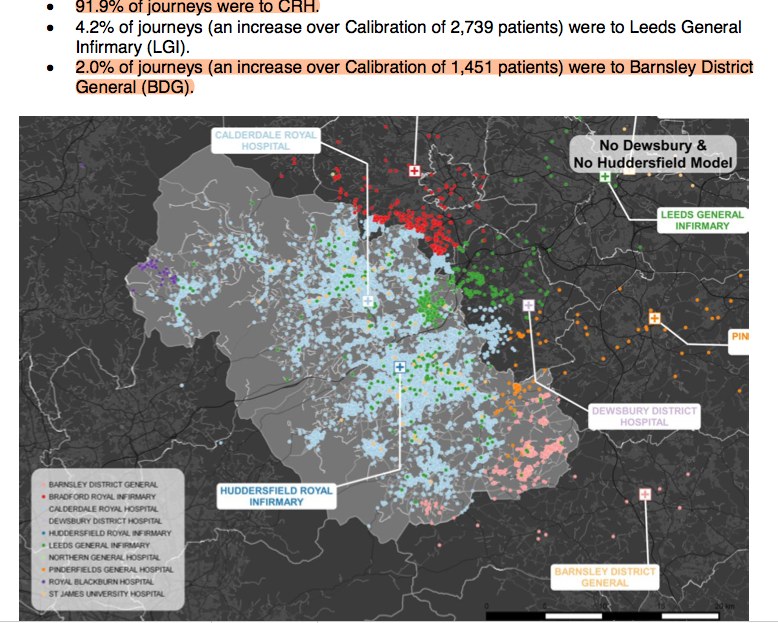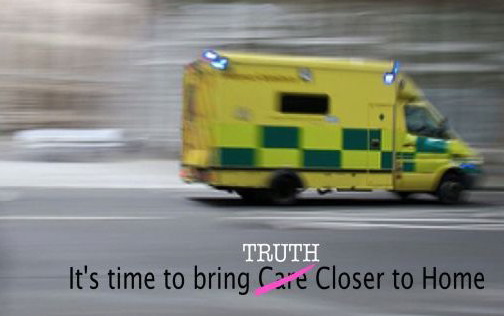The Clinical Commissioning Groups have finally published their travel analysis of the effects of closing Huddersfield A&E, which also includes modelling based on the closure of Dewsbury A&E.
We are still no closer to knowing whether the already overstretched and struggling Yorkshire Ambulance Service is going to be able to cope with the extra 10,071.86 hours journey time/year that would result from the closure of Huddersfield and Dewsbury A&Es, because the travel analysis doesn’t say anything about this, apart from the no-brainer that
“It is recommended that… YAS examine the findings of this report…”
Nor are we any closer to knowing what actual ambulance journey times would be for Kirklees patients – particularly those from South Huddersfield, nor what the projected increase in patient mortality would be, given longer ambulance journey times to A&E.
What the CCGs’ travel analysis shows
The CCGs’ updated travel analysis shows that 91.9% of Calderdale & Kirklees A&E patients would go to Calderdale Royal Hospital A&E; they say this means 84,534 Yorkshire Ambulance Service journeys/patients each year.
(This compares with The Pre-Consultation Business Case (p77) statement that 85% of Calderdale and Kirklees A&E patients would go to CRH, which they said would mean 81,370 Yorkshire Ambulance Service journeys (patients), but it didn’t include “modelling” based on the fact that Dewbsbury District Hospital A&E is to close come September 2016 when it downgrades to an urgent care centre.)

Where A&E patients would go if Huddersfield A&E closes – Info source: Hospital Services Reconfiguration: Travel Analysis (supplementary)
Calderdale CCG Greater Huddersfield CCG Right Care, Right Time, Right Place (RCRTRP) Programme Yorkshire Ambulance Service November 2015
2% of A&E patients will go to Barnsley – 1,794 YAS journeys/patients. The CCGs’ travel analysis says this means an increase of 1,451 patients more than currently go to Barnsley A&E from Kirklees.
Barnsley A&E can hardly cope as it is
The CCG’s travel analysis doesn’t say so, but Barnsley Hospital Foundation Trust records extreme risk status on a number of targets that relate to its ability to absorb an increase in attendance following the proposed closure of the A&E department at HRI.
- Emergency Department mid grade staff recruitment is RED.
- A&E 4 hour target is only 88% met and is RED.
- The Trust is in serious deficit showing RED on two counts.
These recorded risks are shown on P 41 of the February 2016 Trust Board papers within the Corporate Risk Report. This document is downloadable here
And the downgrade of Dewsbury A&E to an urgent care centre in September 2016 will increase Emergency Department activity in CRH by an estimate 7 ED attendances/week.
Increased pressure on Yorkshire Ambulance Service and increased travel times
Closing Huddersfield A&E would mean 10,071.86 hours extra Yorkshire Ambulance Service (YAS) journey time/year.
If Halifax A&E were to close and Calderdale patients were sent to Huddersfield A&E, this would mean an extra 8,787.17 hours extra YAS journey time/year.
Given that YAS is currently struggling to cope with what it already has to do, how is it going to cope with an extra 193 hours more journey time/week if Huddersfield A&E were to close?
The CCGs’ travel analysis report says:
“It is recommended that the RCRTRP Programme Board and YAS examine the findings of this report and agree the implications on the options for the wider reconfiguration of hospital services across the CHFT/Calderdale and Greater Huddersfield CCG areas.”
So, what does YAS make of having an extra 10,072 hours/year journey time if Huddersfield A&E closes? I asked them by email:
The CCGs’ Travel Analysis Report shows that there would be an extra 10,071.86 hours ambulance journey time/year as a result of the closure of Huddersfield and Dewsbury A&Es.The Report says ” It is recommended that… YAS examine the findings of this report…”Please will you tell me:
- If YAS has examined the findings of this report?
- If so, what are YAS’s conclusions?
- In particular, does YAS currently have the resources to cope with an extra 10,071.86 hours extra blue light ambulance journey time/year?
- What resources in terms of ambulance numbers and paramedic numbers are needed to provide 10,071.86 hours of blue light ambulance journey time?
- What are the running costs of 10,071.86 hours of blue light ambulance journey time/year?
- Have the CCGs told YAS they will pay YAS this extra amount to cover the costs of the extra hours of blue light ambulance journey time/year?
On March 2nd I received this reply.
A spokesperson from Yorkshire Ambulance Service NHS Trust said:
“We are working with NHS Calderdale Clinical Commissioning Group, NHS Greater Huddersfield Clinical Commissioning Group and Calderdale and Huddersfield NHS Foundation Trust to fully understand the impact of any proposed changes, particularly around the increase in ambulance resources that would be required.
“Our main priority is to continue to provide high quality, responsive care for patients and their needs are at the core of any future decisions to be made.”
In other words, they don’t understand the impact of the proposed changes, particularly how they would cope with the extra 10k hours ambulance journey time each year.
Increased ambulance journey times
And what of the effect on patient mortality of “average” increase of 6.48 minutes for ambulance journey times?
If you factor in the effect that half of journey times will be unchanged (the ones for Calderdale A&E patients), this means that the “average” increase in ambulance journey time for Kirklees patients will be double that, ie 13 minutes more in the ambulance.
At the Calderdale & Kirklees Joint Health Scrutiny Committee meeting to scrutinise the Clinical Commissioning Groups’ consultation materials that they plan to present to the public, this travel analysis had not been made public or given to Councillors on the Scrutiny Committee.
CCGs must tell the public what ACTUAL ambulance journey times are for Kirklees people furthest from Halifax and what the added risk of patient deaths is
Paul Cooney, Secretary of Huddersfield Keep Our NHS Public, made a deputation statement to the Scrutiny Committee where he said that:
- The Consultation materials should tell people in the most remote parts Kirklees what their ACTUAL ambulance travel time would be, and what effect that would have on expected increases in patients’ deaths.
- Death rates increased by 37% after closure of Newark A&E led to longer patient journeys.
- Two academic studies have found that increased distance to A&E is associated with increased risk of death – reported in the Journal of Emergency Medicine and the Journal of Trauma and Acute Care Surgery
- The draft Consultation Document (p 20) says average ambulance journey time to the “Emergency Centre” at CRH would be 6.48 minutes longer than current average ambulance journey time to A&Es at both hospitals.
- The draft Consultation Document doesn’t say the Journal of Emergency Medicine study, led by Professor Jon Nicholl at Sheffield University, found that 5.8 per cent of patients who travelled less than 6.2 miles to A&E died before being discharged from hospital – but among patients who travelled more than 13 miles, almost nine per cent died.
This was one of the few issues raised in the public deputations that Councillors on the Scrutiny Committee responded to in the meeting. This is what they said:
Cllr Adam Wilkinson said that:
- More info needed about travel times in the public consultation materials, in relation to planned care as well as emergency care. Not just saying that people from some parts of Calderdale may have an extra 45 minutes travel time to Huddersfield planned care hospital – what about existing travel times?
- The public consultation materials need to spell out the clinical impact of travelling further for acute/emergency care – the draft Consultation Doc doesn’t talk about clinical impact of that but the public needs to know possible impact on mortality figures of extra distances.
Cllr Andrew Marchington also said that on p 20 of the draft Consultation Document- impact of travel – the average travel times don’t give full picture. The public needs more detail about the impact of increased actual distances. Also need more info in the public consultation materials about the proposed move of the trauma unit to Calderdale Emergency Centre, because this is a significant service change.
Cllr Barraclough said that mentions of South Huddersfield in the draft consultation document are very vague. The consultation materials need more specific info about Kirkburton, Denby Dale etc. Also need more info about clinical impact of increased travel times.
Public consultation materials will not include information about actual travel distances to A&E or the clinical/patient mortality impacts of increased distances
Cllr Smaje defused the urgency of these questions and the need for the CCGs to put this information into their public consultation materials, by saying that the Joint Health Scrutiny Committee programme of work will be looking at travel.
Why did she do this? Doesn’t she think as overall Chair of the JHSC she should be supporting its members in asking the CCGs to provide the public with full and accurate information in the public consultation materials?
The CCGs took this “get out of jail free” card from Cllr Smaje. They ignored the request for more the public consultation materials to include accurate and more complete information on actual travel distances and the clinical/patient mortality impacts.
Greater Huddersfield CCG Chief Officer Carol McKenna said that the Joint Health Scrutiny Committee wIll have a more detailed session on travel times, when the CCGs will come back to that. They have identified pieces of work on travel times that they want to do.
She said that Trauma will be based at Emergency Centre. Which everyone already knew, and which was why Cllr Marchington had asked for the public consultation materials to include more information about it.
Calderdale Clinical Commissioning Group Chief Officer Matt Walsh said he would take back that need for more detailed trauma info in the public consultation materials and see how to provide it.
CCGs’ travel analysis report and supplementary report are downloadable from this webpage


A splendidly informative article. We are facing similar problems in our county – very rural Shropshire; we may well be able to make use of your analysis to continue our campaign fight to prevent closure of one of our Accident and Emergency departments.
jhb
Hi Joyce, the Shropshire Defend Our NHS campaign is an inspiration to us in Calderdale (& Kirklees). Glad this might be of use to you. There’s a lot more info on the Calderdale & Kirklees 999 Call for the NHS blog and we have found out more info about their travel proposals since this article was written. eg We attended the 19 April Joint Health Scrutiny Committee meeting, where we learned that although the travel analysis was designed around Yorkshire Ambulance Service specifications, it does not include an analysis of the extra time ambulances may take to reach Kirklees patients, given that ambulance drift to areas near A&Es means that it will take time for ambulances to return to Kirklees – where there would be no A&Es.
The road changes between Huddersfield and Halifax will improve the travel situation . Until this was agreed it would have been wasteful to undertake travel analysis based only on existing road.
Surely they must have known of the proposed road changes and could have factored that into travel analysis?